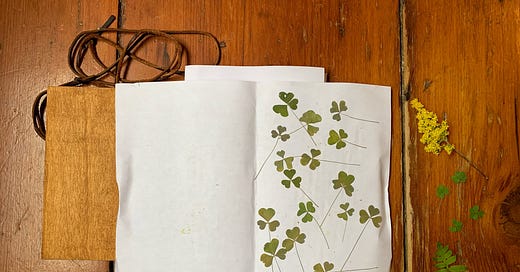Here in the Northern Hemisphere, we’ve just tipped into fall—a time when our ancestors worked tirelessly to preserve every bit of their summer harvest to last them through the long, cold winter. In that spirit, let’s turn our attention to all the green outside our windows—sporting a bit of a gold cast, for sure, but still brilliant and warm weather-reminiscent. Today, we’ll collect a piece and create a verdant beacon of hope to guide us through the dreary, grey months ahead.
The Romanticize
Press a plant.
The Advice
Only pick plants on your property or in a place where you have permission to forage (if you’re on public land, read the rules on collecting first—it’s illegal in most national, state, and local parks and forests).
Harvest sustainably (collect only one sprig of a bunch, and don’t uproot plants; instead, cut off a stem with a clean pair of scissors or clippers to prevent bacterial growth).
Look for plants that are relatively delicate and will press easily—clovers, ferns, crocuses, buttercups, and violets are much thinner and dry more evenly than more robust flowers like zinnia, dahlia, or daisies (anything with a thicker central cone and stem won’t lay perfectly flat even once dried). You can also press leaves—especially if you find some already swathed in their brilliant fall garb.
Dry your plant thoroughly to prepare it for pressing (the less moisture, the less possibility of mold).
Fold a piece of plain white paper and place your plant in between, so the paper sandwiches the plant. Through much trial and error, I’ve found that printer paper or any other unmarked white paper is the best option—newspaper leaves black ink marks on lighter plants, paper towels create indentations in the leaves and petals, and wax paper impedes airflow and makes for very moldy specimens.
Place the paper-folded plant in a plant press or between the pages of a book. If you’re using a book, stack a few more on top of it so it’s weighted down.
Leave your specimen to dry for at least four weeks—if, when you check it, any part of it is still pliable and not completely dry, place it back in its pressing situation and leave it for another week. Keep checking weekly until it’s dry.
Plant pressings are very delicate—I like to store mine in Tupperware containers, but you can also use paper sleeves or Ziploc bags. I recommend using tweezers to grab and move them as you work, to avoid breaking stems, leaves, and petals.
The Inspiration
Blessedly, the rain has paused for the first time in three days; I broke in my new wood stove this morning, and the thick scent of burning oak permeates my little cottage and the fields beyond. Stepping from the warmth into the damp chill, I breathe deep—a mixture of petrichor, sodden soil, woodsmoke, and a hint of sharp leaf rot—and stroll the perimeter of the yard with clippers in hand. I keep my eyes to the ground and bend over to look closer at the trunk-like blades of grass and dry mossy banks sheltered beneath the umbrellas of mushroom pileus; there’s a whole other world at my feet.
The resident groundhog bustles past in a blur of chunky hindquarters and brown fur as I round to the back field, resplendent in a thick yellow carpet of goldenrod, its bright buds set off against the charcoal smudge of sky. I’ve never pressed goldenrod before, but its stem is thin and the ascending cluster of flowers is small enough that it seems worth a shot. I clip a brilliant sunny spray, then get low and discover a patch of ferns—beads of rain dotting their tops like translucent pearls—and add the smallest of their number to my growing collection. Last, I pluck several tiny clovers from a cluster sprouting beside a smooth, flat stone—I scan their ranks for a four-leafed friend, but no such luck today.
There are so many ways to use pressed flowers—you can arrange them in a journal (a deeply soothing activity), glue them to pretty note cards or stationery to add a flourish to your letter, or create a design with them on a bookmark-sized piece of heavy paper, so every time you crack open your latest read in the dead of winter, you’ll be greeted with a slice of eternal summer.
I’d love to know the results of your romanticize—feel free to share your experience in the comments, or tag me on Instagram. For added inspiration, I made a companion reel for this week’s post. Until next Wednesday, fellow romantics!






